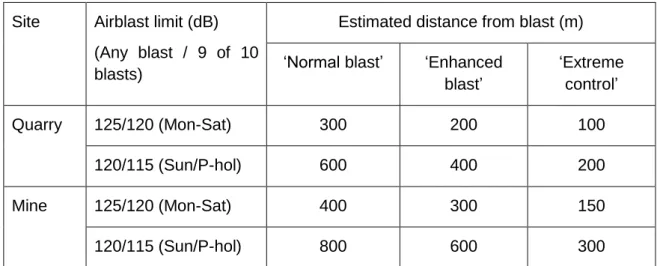Existing mines/quarries with adjacent existing sensitive sites – the impacts experienced on nearby sensitive sites may be difficult to resolve as compliant air blast levels are still considered unacceptable (at least four mine/quarries sites are known to have had blasting related problems which have proven to be difficult solve);. Proposed mines/quarries adjacent to existing noise sensitive areas – current air blasting limits will allow a new mine or quarry to operate within a distance where compatible blasting causes unacceptable impacts (many new mines/quarries avoid this problem by planning their blasting so that they achieve blast levels 5 dB below current limits).
Options to Address the Issue
- What do other jurisdictions do to address the issue?
- What is the range of options to address the issue?
- What are the options to address the issue?
- What are the key features of the options and their effect on regulatory structure?
The directive could be based on the same approach as in preferred option 3 below, with lower airburst limits for 'sensitive locations' and relaxation of the need to meet airburst limits in locations where no one is present at the time of the explosion. Such actions would be based on subjective assessments of the airburst noise by complainants, as legally permissible noise monitoring data may not be available. This option recognizes that imposing a reduction in airburst limits – without any solution to the border compliance problem – is unfair to the industry.
The option retains the structure of the current regulation 11 and only changes the decibel limits. It does not change the requirement to determine airburst levels at the boundary of the receiving site. Non-sensitive locations are understood to mean the part of the noise-sensitive property that is more than 30 meters away from the dwelling, e.g.
Where the detonator believes on reasonable grounds that no person is present at a receiving location at the time of the detonation - air blast limits do not apply.
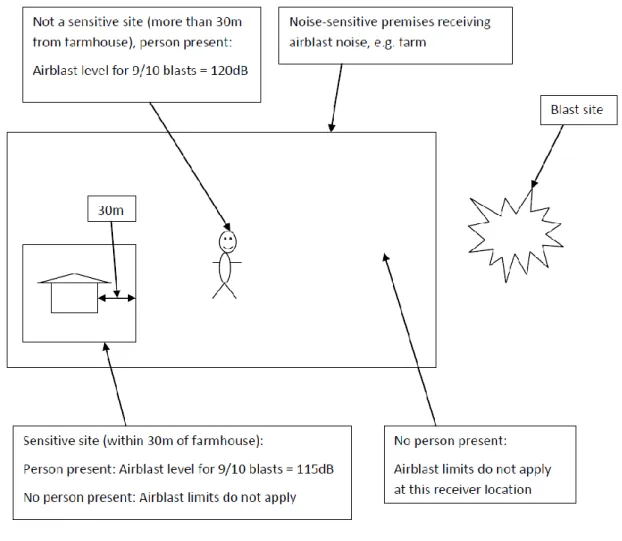
Impact Analysis
Option 1 – Maintain status quo
Where compliance at the limit cannot be practically achieved, the mine or quarry operator will need to seek assistance under noise regulation 17. From the indicative analysis above it can be concluded that full compliance with current air blast limits at the boundary of host premises is likely to impose significant costs on many quarries and some mine sites. The community would experience a benefit if industry were required to achieve strict compliance with current air blast limits at the boundary of host premises, as the resulting air blast levels at the sensitive site (eg home) could be lower than the levels at the border. .
However, this advantage may disappear if the blaster is able to obtain approval under noise regulation 17 to exceed the current air blast limits at the border. As these limits apply at any point on the receiving site, and as current practice has generally been to achieve compliance only at the sensitive site, there is likely to be widespread non-compliance with air blast limits for noise received at the boundary of the receiving site become . In terms of costs to industry, full compliance with the current air blast limits at the boundary of the receiving site is likely to result in significant costs at many quarries and some mine sites.
Addressing the current inconsistency at the border is likely to be costly and inconvenient, with limited benefits to the community.
Option 2 – Reduce airblast limits Impacts on mining industry costs –
From the indicative analysis above it can be concluded that, as with Option 1, full compliance with the reduced air blast limits at the boundary of the host premises is likely to impose significant costs in many quarries and some mining areas. Compliance at the boundary would be impossible for a greater number of mining and quarrying sites than for Option 1. The community would experience a significant benefit if industry achieved compliance with the reduced air explosion limits at the premises boundary. hosting, as of the lowest ones. air blast levels obtained at the sensitive site (eg home) and at the boundary.
However, these benefits can be reduced to be the same as for Option 1 if the blaster is able to obtain regulation 17 noise approval to exceed the reduced boundary air blast limits. As with Option 1, these limits would apply at any point in the receiving premises, and as the current practice has been to achieve compliance only at the sensitive site, there is a potential area of non-compliance with air blast limits for noise received at border. of the receiving premises. In terms of costs to industry, full compliance with reduced air blast limits at the boundary of host premises is likely to impose significant costs on many quarries and some mining areas, with a greater number of areas affected under the Option 2 than under Option 1.
Resolving the current non-compliance at the border becomes more expensive and cumbersome under Option 2 than under Option 1, and these impacts are considered to outweigh the benefits to the community from the lower air exposure levels.
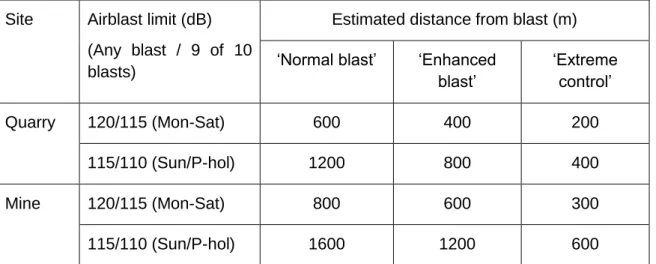
Option 3 – Optimise current regulation Impacts on mining industry costs –
As shown in Table 4.3, Option 3 community benefits from increased protection resulting from reduced levels of airstrikes would be felt at sensitive sites in the Monday-Saturday blasting reception areas. Sensitive sites would be subject to the proposed reduced airstrike restrictions, while other areas where people may be present at the time of an explosion would be subject to the same restrictions as now. In this case, the level of the received air blast would be lower at the sensitive location than at the boundary.
If it is practical for the blaster to achieve compliance with the current boundary air blast limits, then the boundary air blast level is likely to be at or within about 5dB above the current air blast limits and the level at the sensitive site will be at or below the current limit. Under option 3, the current limit would apply to the limit and the reduced limit to. If on the other hand it is not practical for the blaster to achieve compliance at the limit under the current regulations, then it would be possible to seek regulation 17 approval to exceed the limits at the limit, and then the blaster would be compliant with the current. borders in the sensitive country.
Under Option 3, the blaster would need to reduce the sound level at the sensitive site to meet the new limits, and as discussed above should generally be achievable as the sensitive site is far from the boundary in this scenario.
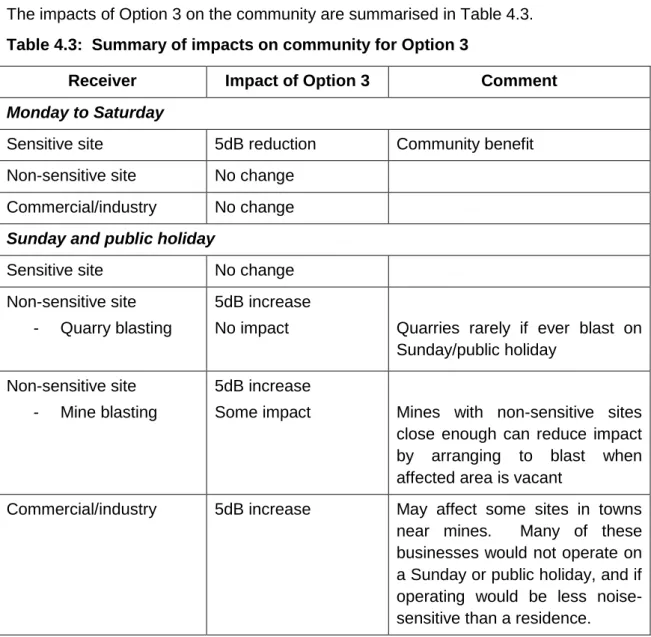
Consultation
Consultation on proposed changes to airblast levels
The consultation on the proposed changes to air blast levels was carried out as part of the wider consultation described above. During the consultation period, face-to-face contact with the industry was made through a presentation to the Environmental Management in Mining Conference and a three-hour seminar presented by DEC which was attended by approximately 20 representatives of the mining industry and relevant consultants . It was during this seminar that many of the issues that led to the reforms contained in Option 3 were raised.
At the end of the consultation period, 11 submissions were received on the proposed changes to the air blast limits. Some of the submissions contained significant detail to support the views that had been presented at the seminar. The result of this process was a revised proposal for changes to air blast limits that addressed the industry's fundamental concerns.
The guidelines will be developed in consultation with industry to ensure their relevance to users.
Preferred Option
- Identification of preferred option and why selected
- How is this option the most effective and efficient in attaining policy objectives?
- Are compliance, administrative or enforcement costs justifiable?
- Is the preferred option appropriate?
Compared to Option 1 (status quo), Option 3 provides a higher level of protection for the 'sensitive site' receiver for blasting from Monday to Saturday, and the same level of protection for Sundays and public holidays. For less sensitive locations Option 3 provides the same level of protection as Option 1 for Monday to Saturday, but a lower level of protection on Sundays and public holidays. There is general acceptance in the mining and quarrying industry, evident through consultation, that there is value in providing a higher level of protection for the sensitive area than is currently provided.
The existing regulations for noise (other than blasting) provide higher levels of protection for Sundays and public holidays than for weekdays, but this is only for the continuous types of noise that are present for more than 1% of the time: for 'one-off' . The ANZEC Guideline and AS2187 both discourage blasting on Sundays and public holidays, without giving reasons, but presumably because a higher level of noise amenity is valued at sensitive sites on those days. These less sensitive sites are not considered to necessarily require the same level of protection on a Sunday or public holiday as is required on a sensitive site.
In the end, Option 3 represents the best fit with the objectives of the regulation amendment strategy, providing a significant improvement in the level of protection for the community where it is most needed, solving a regulatory failure in the current system.
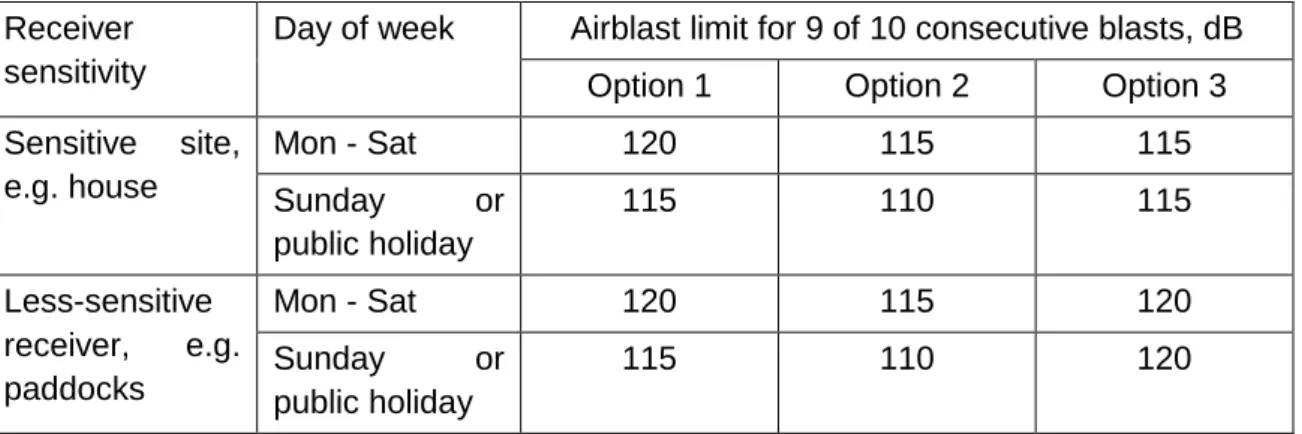
Implementation and Evaluation Strategy
Eco Access Guide – Noise and Vibration from Blasting, Environment Protection Agency, Queensland, March 2006 (Ref: www.derm.qld.gov.au). Environment Protection Authority Report on the Operation and Effectiveness of the Noise Regulations, Environment Protection Authority, October 1999. Proposed Environmental Protection (Noise) Amendment Regulations 2010 – Explanatory Notes, Department of Environment and Conservation, WA, January 211.
Proposed changes to airburst limits - Discussion Paper, Department of Environment and Conservation, WA, January 2011 (Ref: www.dec.wa.gov.au). Review of Environmental Protection (Noise) Regulations 1997 - Blasting Noise, Orica Quarry Services, Fremantle, 2010 (published in DEC Discussion Paper, 2011). Proposed Environmental Protection (Noise) Amendment Regulations 2010 – Public Consultation Report, Department of Environment and Conservation, WA, December 2011 (Ref: www.dec.wa.gov.au).
Western Australian Mineral and Petroleum Statistics Digest 2011, Department of Minerals and Petroleum, WA (Ref: www.dmp.wa.gov.au).
Preferred Option – Option 3
With Explanatory Notes
